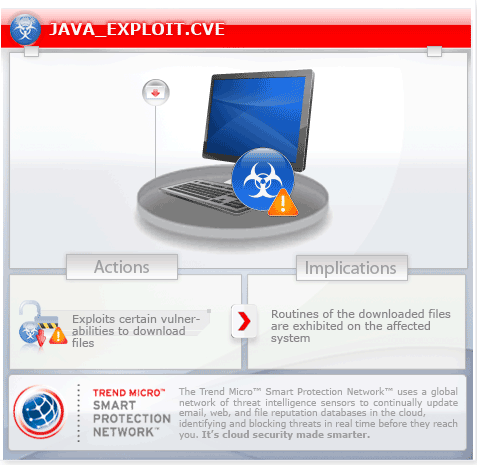JAVA_EXPLOIT.CVE
Exploit:Java/CVE-2013-0431 (Microsoft); Java.Exploit.CVE-2013-0422.C (F-Secure)
Windows 2000, Windows Server 2003, Windows XP (32-bit and 64-bit), Windows Vista (32-bit and 64-bit), Windows 7 (32-bit and 64-bit)


Threat Type: Trojan
Destructiveness: No
Encrypted: No
In the wild: Yes
OVERVIEW
Downloaded from the Internet
This malware exploits vulnerabilities related to CVE-2013-0431.
To get a one-glance comprehensive view of the behavior of this Trojan, refer to the Threat Diagram shown below.

This Trojan may arrive bundled with malware packages as a malware component. It may be hosted on a website and run when a user accesses the said website.
TECHNICAL DETAILS
Varies
Java Class
21 Feb 2013
Downloads files
Arrival Details
This Trojan may arrive bundled with malware packages as a malware component.
It may be hosted on a website and run when a user accesses the said website.
Download Routine
This Trojan takes advantage of the following software vulnerabilities to download possibly malicious files:
It saves the files it downloads using the following names:
- %User Profile%\{Random File Name}.exe
(Note: %User Profile% is the current user's profile folder, which is usually C:\Documents and Settings\{user name} on Windows 2000, XP, and Server 2003, or C:\Users\{user name} on Windows Vista and 7.)
It downloads a possibly malicious file from a certain URL. The URL where this malware downloads the said file depends on the following parameter(s) passed on to it by its components:
- val
- prime
Other Details
This Trojan executes the downloaded file using the following commands:
- regsvr32 -s %User Profile%\{file name}.exe
- %User Profile%\{file name}.exe
(Note: %User Profile% is the current user's profile folder, which is usually C:\Documents and Settings\{user name} on Windows 2000, XP, and Server 2003, or C:\Users\{user name} on Windows Vista and 7.)
SOLUTION
9.300
9.744.01
21 Feb 2013
9.745.00
21 Feb 2013
Step 1
Before doing any scans, Windows XP, Windows Vista, and Windows 7 users must disable System Restore to allow full scanning of their computers.
Step 2
Close all opened browser windows
Step 3
Scan your computer with your Trend Micro product to delete files detected as JAVA_EXPLOIT.CVE. If the detected files have already been cleaned, deleted, or quarantined by your Trend Micro product, no further step is required. You may opt to simply delete the quarantined files. Please check this Knowledge Base page for more information.
Step 4
Download and apply these security patches Refrain from using these products until the appropriate patches have been installed. Trend Micro advises users to download critical patches upon release by vendors.
Did this description help? Tell us how we did.

